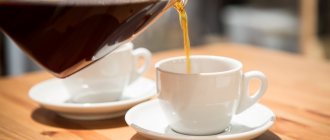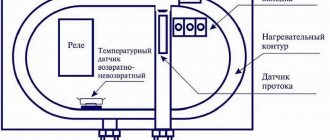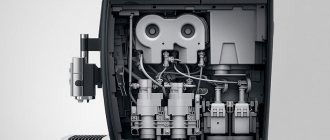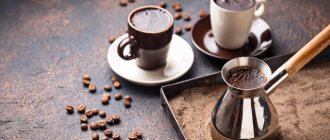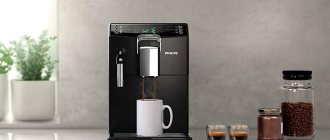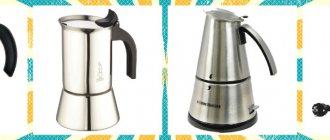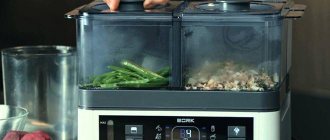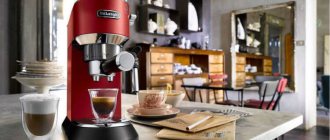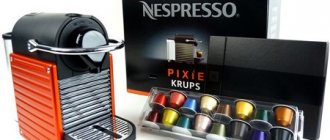Variety
There are mainly two types of coffee trees cultivated on plantations: Coffea arabica and Coffea robusta. Arabica gives coffee an oily texture, rich aroma, sourness and sweetness. Robusta adds bitterness, but makes the drink thicker and saturates it with caffeine. These varieties are characterized by a pronounced invigorating effect.
Arabica coffee accounts for 70% of world production; many single varieties of this species can be found on sale. Robusta is added to mixtures to increase the strength, give a thick consistency and obtain a fluffy foam. Blends (mixtures) presented on store shelves, as a rule, contain up to 20% robusta. Manufacturers indicate information about the composition on the packaging, so when choosing, you can partially predict the final taste of the drink.
Roasting
During temperature treatment, the chemical composition of grains changes, up to 30% of new compounds are formed in them, which affect the taste. The amount of organic acids decreases, substances appear that give coffee chocolate, caramel and nutty shades. Light roasting produces herbaceous and acidic tones, while strong roasting makes the coffee oily and introduces characteristic bitter notes.
Roast selection:
- weak – weak morning coffee with milk;
- medium - American;
- strong – espresso, ristretto.
The universal roast for most coffee makers is medium.
You can experiment with heavily roasted grains in a carob and in a Turk - with this method of cooking, the taste will reveal itself brighter.
Grinding
Grinding coffee for a coffee maker is one of the decisive factors influencing the final taste of the drink. During heat treatment, the substances contained in the beans are extracted: caffeine, essential oils and organic compounds. The smaller the particles, the faster this process takes place.
The choice of grind depends on the cooking method:
- medium-coarse – drip coffee makers;
- medium – carob and geyser models, French press;
- thin and ultra-thin - Turk.
Correctly adjusted grinding is especially important for the quality of espresso, which is prepared in coffee makers with a holder (carob).
Carob coffee makers
In this type of machine, espresso is brewed using steam, which passes through a coffee tablet under high pressure.
Indicators of proper preparation of the drink:
- uniform flow of coffee into the cup;
- uniform foam color without black and white spots;
- moderately moist and dense coffee tablet after preparation.
You can determine the appropriate degree of grinding experimentally - water flows more intensively through too large fractions, and the drink turns out to be too liquid, and the tablet acquires a loose structure after preparation. If the situation is exactly the opposite and the particles are too small, the liquid will have difficulty passing through the holder, leaking out in drops.
There are many varieties of machine coffee available in the market. The leaders are Lavazza, Molinari, Illy and Paulig. The best espresso comes from freshly ground coffee, so give preference to bean varieties.
It is not recommended to use varieties with aromatic additives in carob coffee makers. The substances leave a strong odor in the coffee maker. Cheap products may have chemical components added that destroy the elements of the device.
Learning to choose the type of grain grinding
The degree of grinding is selected depending on the method and utensils used to prepare coffee.
French press
The peculiarity of brewing coffee in such a machine is that the drink releases its properties by infusing it in gradually cooling water. If the grind is fine, the beans will release too many minerals and tannins, and the result will be a tasteless drink.
Therefore, for a French press you should take coarsely crushed grains - the size of the fractions should be the size of grains of table salt. In this case, the preparation time for coffee in a French press will be 3-4 minutes.
Be sure to read: At what age can children drink coffee?
Cupping, coffee in a cup
If coffee is brewed in a cup, then it is better to take large-fraction coffee. And in order for the finished drink to remain aromatic, it should not be brewed with boiling water, but with hot water – 90-92°C. In this case, the coffee infusion time in the cup will be 4 minutes.
Other brewing options – Chemex, pour-over, siphon
Coffee prepared using such devices turns out incredibly tasty, rich and aromatic. That's why it is very popular among coffee lovers.
If you use coffee brewing methods such as siphon, Chemex, or pour-over, then it is advisable to use medium-sized beans.
Baristas with extensive experience strongly recommend taking into account the size of the device used for making coffee:
- for a pour over that is small in size and volume, it is better to take beans of a universal grinding degree - finer;
- When using a Chemex, a coarse grind size would be preferable, since the filter of the device is dense and water leaks through them slowly.
Geyser and drip coffee machines
For such devices, the priority will be a universal/medium type of grain grinding. Outwardly, it looks more like fine-grained sugar or river sand.
This degree of grinding is perfect for geyser, most carob and drip coffee makers.
If you use finely ground beans to make coffee, the extraction will occur too quickly and the result will be a bitter, tasteless drink.
Universal coffee machines
Automatic coffee makers prepare coffee using the pour-over method. And if the grinding is coarse, then in the indicated 25-30 seconds the crushed beans will not have time to impart their aromatic and taste properties to the drink.
Therefore, in this case, it is better to take fine/espresso grind beans. Externally, grains of coffee beans are similar in size to fractions of Extra salt.
In addition, the quality of the drink in this case also depends on the uniformity of the grind. If the coffee mixture contains inclusions of large particles, then the drink may taste slightly sour.
For Turks/Cezves
For Turkish coffee, it is necessary to use the finest, ultra-fine grind coffee. Externally, this grinding can be compared to powdered sugar.
If you take beans that are more coarsely ground, then the extraction will not have time to complete and the drink will turn out watery, unsaturated with noticeable sourness.
Advice! There is one very important rule in the coffee topic: the less time the coffee interacts with water, the smaller the grains of beans should be. And the opposite: the longer the coffee is brewed, the larger the particles of crushed beans should be.
Drip coffee makers
The devices have a simple design. There is a heating element at the bottom of drip coffee makers. The top container contains a filter where coffee powder is placed. The water is heated, passes through the ground grains and enters a transparent flask. Such models are designed for preparing Americano; it is impossible to get real Italian espresso in them.
For drip models, only medium-coarse grinding is suitable. The filter holds large particles well, but smaller fractions can leak into the flask and ruin the structure of the drink. In order not to make a mistake when choosing ground coffee, pay attention to the labeling - the packs should have an image or inscription indicating that the product is intended for drip coffee makers.
The best taste comes from grains with pronounced acidity. Single varieties and mixtures of various types of Arabica from Guatemala, Dominican Republic and Costa Rica are suitable. For an invigorating effect, choose coffee with up to 10% robusta added. If the percentage is higher, the drink may not be as aromatic and have a pronounced bitterness. A wide range of products for drip coffee makers is offered by the Finnish company Paulig.
How to properly prepare grains for grinding
First of all, the beans must be thoroughly dried and roasted before grinding. Moreover, the less time has passed from the moment of roasting the grains to their grinding and preparation, the tastier and more aromatic the drink will be.
If the grains are under-dried, they must be brought to the desired condition. Coffee shops use special Aeropresses, but at home you can dry the beans using an oven.
The time it takes to grind the beans depends on their size. Arabica is larger in size, while Robusta is slightly smaller.
It is not advisable to grind beans for future use. It is better to grind several portions to brew fresh coffee. When crushed grains come into contact with air, the first ones very quickly begin to lose their aromatic properties, so if they remain crushed for a long time, the result will be a not very aromatic drink.
Geyser coffee makers
The device is a coffee pot with a screw-on bottom container that is filled with water. The principle of operation is reminiscent of a natural phenomenon - during boiling, steam is formed, which pushes water upward. The liquid passes through a filter filled with ground coffee.
The degree of grinding will be of great importance for the quality of the drink. An ultra-fine filter will not work here - small particles clog the filter and prevent the free passage of water. Fractions that are too large do not have time to release most of the substances; as a result, the drink may turn out to be liquid and not aromatic.
For geyser coffee makers, medium grind coffee is suitable, with a consistency reminiscent of semolina. If you grind your own coffee, keep an eye on the time. The operating time of the coffee grinder is no more than 20 seconds. Subsequently, the knives in most models begin to heat up, which leads to oxidation of the product and the appearance of bitterness.
Equipment for grinding coffee beans
It is possible to grind grains using the following equipment:
- manual coffee grinder;
- mechanical shredder;
- food processor;
- electric shredder;
- professional coffee grinders, rotary machines.
A manual coffee grinder with a burr is most often used when it is necessary to obtain a medium degree of grinding of beans. It is also worth considering that this method does not guarantee grinding uniformity.
In addition to grinding beans in a manual coffee grinder, its blades need to be systematically sharpened, manually, which will take a lot of effort and time. And the lack of any configured functions does not allow you to regulate the process of grinding grains.
Advice! Do not save time on the process of chopping beans - chopping the beans too quickly will lead to unevenness of the resulting mixture. And this, in turn, will negatively affect the quality of the finished drink.
Grinding beans using a mechanical coffee grinder is a good alternative to the previous method. Here the manufacturer already indicates on the device the degree of grinding that can be obtained using a specific model of coffee grinder.
Be sure to read: Which coffee beans are the best in terms of price and quality
It is also worth noting that with the help of a mechanical grinder it is possible to obtain coffee fractions of uniform size, ideal for further preparation of tasty and aromatic coffee.
It is possible to grind beans in a coffee processor, but you should understand that this machine is not a specialized device for grinding beans. Therefore, you should not expect high quality and uniformity of crushed grains. In addition, despite the mechanical operation of the machine, it will take longer to grind the beans than with a manual coffee grinder.
But, despite conflicting opinions, in the absence of a full-fledged coffee grinder, this option for grinding beans can be considered. Often, using a food processor can achieve a medium grind.
An electric chopper is a small flask with knives. Immersion blenders are most often equipped with a similar device. It is also possible to purchase the shredder separately.
In general, the model has certain similarities with a food processor, the only differences are in size - the chopper is smaller. Therefore, it will do the same amount of work as a food processor.
And since the knives in the chopper are non-replaceable, that is, they cannot be replaced with other, thinner, smaller ones, the output is a coarse degree of grinding. This option is more suitable for coffee makers.
Well, in conclusion, I would like to say a few words about professional coffee grinders. Many coffee shops are equipped with similar equipment. Coffee grinders have a lot of functions, ranging from the ability to select the size of the output fractions, and ending with determining the moisture content of the beans, which affects the roasting process and the time of grinding.
The chamber of professional coffee grinders is large and allows you to get up to 10 kg of crushed beans in an hour.

